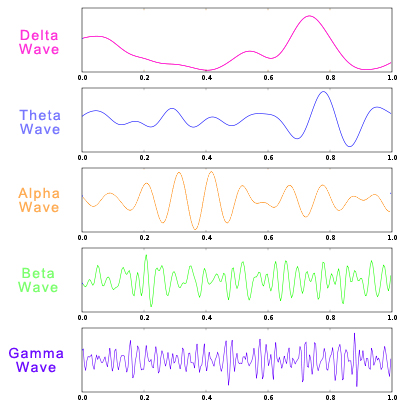Different Types of Brain Waves: Delta, Theta, Alpha, Beta, Gamma
Our brain consists of 5 different types of brain waves; Delta, Theta, Alpha, Beta and Gamma brain waves. Each of these of these brain waves has a normal frequency range in which they operate. The table below gives a brief overview of the primary function of these brain waves.
Frequency range |
Name |
Usually associated with: |
> 40 Hz |
Gamma waves |
Higher mental activity, including perception, problem solving, and consciousness |
13–39 Hz |
Beta waves |
Active, busy thinking, active processing , active concentration, arousal, and cognition |
7–13 Hz |
Alpha waves |
Calm relaxed yet alert state |
4–7 Hz |
Theta waves |
Deep meditation /relaxation, REM sleep |
< 4 Hz |
Delta waves |
Deep dreamless sleep, loss of body awareness |

Each type of brainwave controls a variety of states of consciousness ranging from sleep to active thinking. While all brain waves work simultaneously, one brainwave can be more predominant and active than the others. The dominant brainwave will determine your current state of mind. So if you are awake and relaxed you would be considered to be in an "alpha state of mind" because your Alpha brain waves would be the strongest with the highest amplitude.
To recap: each brain wave has a frequency it operates at (Hz). The frequency ranges listed above are the "normal" ranges these brain waves should operate at; however, they can fall out of these ranges. Each brain wave has an amplitude (uV) which determines the strength of the brainwave; this, in turn, determines your active state of mind. All brainwave types can be active at the same time but some will be more active than others having the highest amplitude.
In a perfect healthy brain all your brain waves fall within these normal ranges and you have the correct strong dominant brainwave depending on your state of mind. If this is the case, you are feeling FANTASTIC, waking up feeling energetic, in a completely relaxed state, focused, happy, feeling sharp and clear, essentially feeling good all the time, Congratulations! You are a zen monk! But, let’s get back to reality. This is more or less impossible to achieve. Our brain waves are probably not falling within the correct range-- some may be a little too high while others are too low. Everything in our daily lives—from stress, poor diet, lack of exercise, trauma, pollution, the environment, and more-- causes our brain waves to become unbalanced. Fortunately, we can use brainwave entrainment tools like Itsu Sync to help rebalance our brain waves.
The Effects of Specific Brain Waves
Each different brainwave has a certain effect at a specific frequency. The list below will break down the different brainwave ranges to specific frequencies listing their effects.
Delta Brain Waves (0.5Hz - 4Hz)

0.5 Hz - Complete relaxation and headache relief.
0.5-1.5Hz - Natural pain relief through stimulating endorphin release.
0.9 Hz - Euphoric state.
1 Hz - Feeling of well-being; stimulation of pituitary glands to release growth hormones (helps recover from injuries, rejuvenate, and develop muscles).
2 Hz - Nerve regeneration.
2.5 Hz - Further pain and migraine relief from production of endogenous opiates. Natural sedative effect.
1-3 Hz - Restorative sleep and profound relaxation.
3.4Hz - Restful sleep.
3.5 Hz - Feeling of calmness, reducing anger and irritability. Retention of languages.
4Hz - Enkephalin release for natural stress and pain reduction. Improved memory, subconscious learning and problem solving.
Theta brain waves (4Hz - 7Hz)

4.5 Hz - Brings you into what is referred to as "the Tibetan state of consciousness", a state of meditation.
4.9 Hz - Induced relaxation, meditation, introspection, and a deeper sleep.
5 Hz - State of unconscious problem solving. Less sleep is needed due to the Theta waves replacing the need for extensive dreaming. Beta endorphin release as a natural pain killer.
5.35 Hz - Deeper breathing, relaxing the lungs.
5.5 Hz - Giving the feeling of intuition, your inner guidance, and "gut feeling".
5.8 Hz - Reduce fear, absent-mindedness, and dizziness.
6 Hz - Improves long-term memory and motivation; reduces procrastination and unwillingness to work.
4.5 Hz - 6.5 Hz - Waking dreaming (day dreaming) with vivid images.
6.5 Hz - Activates the frontal lobe which controls creativity.
6.2 Hz - 6.7 Hz - Activates Frontal Mid-line Theta that is active when engaged in cognitive activity such as solving math problems, playing Tetris, or other similar types of quick passive problem solving tasks.
6.88 Hz - Effects balance and stability.
3 Hz - 8 Hz - Deep relaxation, meditation, lucid dreaming, increased memory, focus, and creativity.
4 Hz - 7 Hz - Inner peace and emotional healing which lowers mental fatigue.
6 Hz - 10 Hz - Creative visualization, starts at 6Hz and moves up to 10Hz.
Alpha brain waves (7Hz - 13Hz)

7.5 Hz - Creative thought is activated for music, art, invention, and problem solving. Overcoming troublesome issues or problems due to ease in finding solutions through re-evaluation. This is a type of inter-awareness of self purpose.
7.83 Hz - The Schumann Resonance. Very grounding as it is the same frequency as the magnetic field of the earth.
7.5 Hz - 8 Hz - For treating addictions, drug, alcohol, food, etc. Gives the person the "satisfied" feeling that they would normally get from their addiction.
8 Hz - 14 Hz - Qi Gong.
8.3 Hz - Heightens clairvoyance around visual images and metal objects.
8 Hz - 8.6Hz - Reduced stress and anxiety.
8 Hz - 10 Hz - Start of "super learning", your passive ability to learn new information and memorize. It activates creative problem solving and intuitive insights. This is not an active focus on learning but a relaxed state your mind is in absorbing without active concentration.
9 Hz - Brings awareness of body imbalances.
10 Hz - Increased serotonin release bringing mood elevation, arousal; relives headaches and stimulates the body. Will bring clarity to the mind and give subconscious correlation.
10 Hz - 12 Hz - Improves the mind, body connection.
10.5 Hz - Lowers blood pressure. Associated with the Heart Chakra which is related to the Thymus, heart, blood, and circulatory system.
10.6 Hz - Relaxed and alert.
11 Hz - Brings you to a relaxed yet awake state. Can be a lucid state (day dreaming) but not from tiredness. Thoughts and emotions may pleasantly drift through your mind bringing calm. It can be a bridge between the conscious mind and the unconscious mind. Gives stress reduction.
12 Hz - Gives mental stability.
12 Hz - 14 Hz - Improves learning by absorbing information when you plan to think about it later.
12.3 Hz - Improves visualization.
Beta brain waves (13Hz - 39Hz) & Gamma brain waves (40Hz+)

13 Hz - 27 Hz - Focus with attention toward external stimuli. The normal waking consciousness, active thought process, and alert mental activity.
13 Hz - 30 Hz - Processing outside data your brain takes in, problem solving and active conscious thinking. A very wakeful state which combats drowsiness.
14 Hz - An awake, alert state. Allows you to focus and concentrate on tasks.
15 Hz - 18 Hz - Increases your mental abilities including focus, alertness, attentiveness and IQ. You are aware of yourself and surroundings and are alert but not agitated.
16 Hz - Stimulates oxygen/-calcium release into cells.
18 Hz - 24 Hz - Euphoria and ecstasy, similar to a runners high with serotonin release around 22Hz.
18+ Hz - A fully awake state with normal alertness. Significant improvements can be seen in memory, reading, spelling, math, and planning.
20Hz - Stimulation of the pineal gland. The frequency can help with tinnitus.
20 Hz - 40 Hz - Ideal meditation frequency for stress release.
31 Hz - Release of growth hormone, can help to develop muscles and recover from injuries (rejuvenation effects).
32Hz - Enhanced vigor and alertness.
33 Hz - Christ consciousness and the Pyramid frequency.
35 Hz - Balance of all chakras.
36 Hz - 44 Hz - The learning frequency range; will help maintain alertness when actively studying or thinking. Related to the prepiriform cortex and amygdala. Coordinates processing of information in different areas of the brain simultaneously.
38 Hz - Endorphin release.
40 Hz - Having efficient 40Hz activity creates a good memory also dominant in problem solving. Important for information and high-level information processing. A lack of this frequency can create learning disabilities.
40 Hz - 60 Hz - Can stimulate the release of beta-endorphins and give anxiolytic effects.
55 Hz - Tantric yoga which stimulates the "kundalini".
62 Hz - Feeling of physical vigor.
72 Hz - The emotional spectrum.
40+ Hz - The higher gamma frequencies are less specific occurring over larger ranges and are mostly related to intelligence, problem solving, focus, memorization, concentration, etc. They can be looked at as an enhancement for a lot of the benefits of the beta frequencies .
